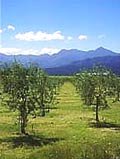"People who live among olive trees tell you their
air is pure and their lives are full. They expect
miracles as a matter of course. All the growers I've met
in New Zealand are mad, they're all romantics, they know they're never
going to make any money!"
-Peta Mathias, chef and TV personality, at the NZOA
conference in Nelson, March 1999.
Jokes aside, many in the region are being attracted to
the passion that surrounds this ancient and almost sacred
tree. Sjef Lamers, from Sustainable Nutrition in
Wakefield explains; " Olive growing is linked to
cool climate viticulture, and being a plant from a dry
Mediterranean climate they don't like wet feet. The
higher your rainfall, the more free draining your soil
should be. Mediterranean soils are more alkaline and we
need to do something on the chemical balance within the
soil, which is an important aspect. Careful site
selection can bring these two points together and I think
the future of NZ olive growers is looking well within the
pockets that are suitable."
Numerous varieties have been imported, grown and are
for sale in New Zealand and it is important to consider
the origins of available trees. Consider also that some
olives are for ornamental purposes only and are non
fruiting, while some varieties are suitable for pickling
and table olives, and some for the precious oil
production. Plant what is most likely to succeed on the
chosen site and not just what cultivar is available at
the time.
Being wind pollinators, the grove layout should
consider the prevailing wind at flowering time.
Pollination is also adversely affected by rain fall, high
humidity, hot dry winds and a lack of good pollinating
tree varieties. A good mix of cultivars throug h the
grove with healthy trees that are free from disease, with
adequate irrigation will help produce the best cropping.
Ideally the planting area should be ripped to 60-70cm
for greater aeration and drainage with fertiliser and/or
compost worked in well with a rotary hoe. Don' t be
tempted to drop fertiliser directly down the hole, and
water well as soon as planted. Plants should be staked or
attached to wires for good support in the early stages
and sprayguards are an excellent idea in a conventional
system.
The desired outcomes of pruning are an even light
penetration through the canopy and a reduction of insect
and disease development by eliminating overcrowding of
branches in the tree centre. Olives fruit on second year
wood meaning this season's growth produces next
season\rquote s fruit. Fruiting is mainly confined to
20-30cms of the tree shell, with the most productive
shoots being 20-30cms long. Excessively vigorous or short
shoots are less productive.
Small grove owners often pickle their own table olives
and it is now possible to get smaller quantities pressed
into oil locally. On a commercial scale the extra virgin
olive oil is where the money is, and most is currently
marketed by the grower themselves. It is highly sought
after, gets good prices and is selling very well.
Further down the track contract growing will develop,
as has happened and been so successful in the NZ wine
industry. "New Zealand produces oils comparable to
Tuscany and can compete very successfully," Hamish
MacFarlane said as grower and member of the industry
advisors panel at the NZOA conference.
"We have the benefit here of not being bogged
down with tradition and we can make use of better
varieties, with lower production costs while in Europe
their subsidies will be coming off. We're starting with a
clean slate and if done properly we will be very
competitive." He adds," a time will come when
people will become aware of ' fresh' olive oil and we are
out of season to drop it onto the London markets. We will
look after the local market; however all primary produce
in NZ is geared for the export market."
Jeryl Alldred has a 50 acre olive grove on Waiheke
Island with 900 trees, another 1000 gone in this year
with plans for 3000, comprising of 15 varieties. She is
also the president of the New Zealand Olive Association.
Her advice for people considering olive growing -
"really do your homework first. Go and look at
groves in the area where you're thinking of planting
trees, and at the end of the day if you don't have a
passion for the actual olive tree, go away and plant
apples."
